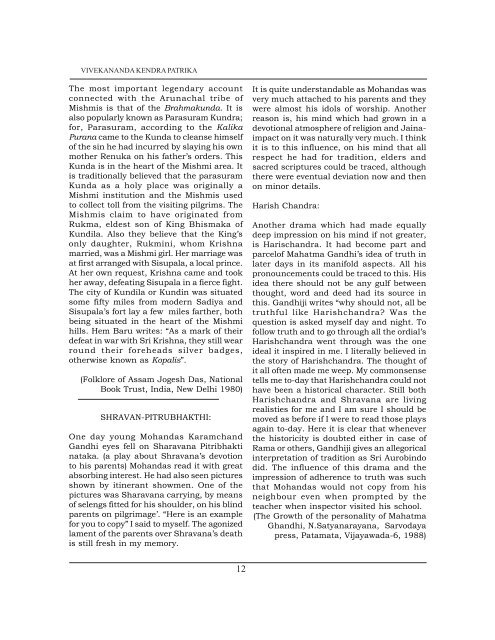Epics in Imprints-1.pdf - Vivekananda Kendra Prakashan
Epics in Imprints-1.pdf - Vivekananda Kendra Prakashan
Epics in Imprints-1.pdf - Vivekananda Kendra Prakashan
You also want an ePaper? Increase the reach of your titles
YUMPU automatically turns print PDFs into web optimized ePapers that Google loves.
VIVEKANANDA KENDRA PATRIKA<br />
The most important legendary account<br />
connected with the Arunachal tribe of<br />
Mishmis is that of the Brahmakunda. It is<br />
also popularly known as Parasuram Kundra;<br />
for, Parasuram, accord<strong>in</strong>g to the Kalika<br />
Purana came to the Kunda to cleanse himself<br />
of the s<strong>in</strong> he had <strong>in</strong>curred by slay<strong>in</strong>g his own<br />
mother Renuka on his father’s orders. This<br />
Kunda is <strong>in</strong> the heart of the Mishmi area. It<br />
is traditionally believed that the parasuram<br />
Kunda as a holy place was orig<strong>in</strong>ally a<br />
Mishmi <strong>in</strong>stitution and the Mishmis used<br />
to collect toll from the visit<strong>in</strong>g pilgrims. The<br />
Mishmis claim to have orig<strong>in</strong>ated from<br />
Rukma, eldest son of K<strong>in</strong>g Bhismaka of<br />
Kundila. Also they believe that the K<strong>in</strong>g’s<br />
only daughter, Rukm<strong>in</strong>i, whom Krishna<br />
married, was a Mishmi girl. Her marriage was<br />
at first arranged with Sisupala, a local pr<strong>in</strong>ce.<br />
At her own request, Krishna came and took<br />
her away, defeat<strong>in</strong>g Sisupala <strong>in</strong> a fierce fight.<br />
The city of Kundila or Kund<strong>in</strong> was situated<br />
some fifty miles from modern Sadiya and<br />
Sisupala’s fort lay a few miles farther, both<br />
be<strong>in</strong>g situated <strong>in</strong> the heart of the Mishmi<br />
hills. Hem Baru writes: “As a mark of their<br />
defeat <strong>in</strong> war with Sri Krishna, they still wear<br />
round their foreheads silver badges,<br />
otherwise known as Kopalis”.<br />
(Folklore of Assam Jogesh Das, National<br />
Book Trust, India, New Delhi 1980)<br />
SHRAVAN-PITRUBHAKTHI:<br />
One day young Mohandas Karamchand<br />
Gandhi eyes fell on Sharavana Pitribhakti<br />
nataka. (a play about Shravana’s devotion<br />
to his parents) Mohandas read it with great<br />
absorb<strong>in</strong>g <strong>in</strong>terest. He had also seen pictures<br />
shown by it<strong>in</strong>erant showmen. One of the<br />
pictures was Sharavana carry<strong>in</strong>g, by means<br />
of selengs fitted for his shoulder, on his bl<strong>in</strong>d<br />
parents on pilgrimage’. “Here is an example<br />
for you to copy” I said to myself. The agonized<br />
lament of the parents over Shravana’s death<br />
is still fresh <strong>in</strong> my memory.<br />
12<br />
It is quite understandable as Mohandas was<br />
very much attached to his parents and they<br />
were almost his idols of worship. Another<br />
reason is, his m<strong>in</strong>d which had grown <strong>in</strong> a<br />
devotional atmosphere of religion and Ja<strong>in</strong>aimpact<br />
on it was naturally very much. I th<strong>in</strong>k<br />
it is to this <strong>in</strong>fluence, on his m<strong>in</strong>d that all<br />
respect he had for tradition, elders and<br />
sacred scriptures could be traced, although<br />
there were eventual deviation now and then<br />
on m<strong>in</strong>or details.<br />
Harish Chandra:<br />
Another drama which had made equally<br />
deep impression on his m<strong>in</strong>d if not greater,<br />
is Harischandra. It had become part and<br />
parcelof Mahatma Gandhi’s idea of truth <strong>in</strong><br />
later days <strong>in</strong> its manifold aspects. All his<br />
pronouncements could be traced to this. His<br />
idea there should not be any gulf between<br />
thought, word and deed had its source <strong>in</strong><br />
this. Gandhiji writes “why should not, all be<br />
truthful like Harishchandra? Was the<br />
question is asked myself day and night. To<br />
follow truth and to go through all the ordial’s<br />
Harishchandra went through was the one<br />
ideal it <strong>in</strong>spired <strong>in</strong> me. I literally believed <strong>in</strong><br />
the story of Harishchandra. The thought of<br />
it all often made me weep. My commonsense<br />
tells me to-day that Harishchandra could not<br />
have been a historical character. Still both<br />
Harishchandra and Shravana are liv<strong>in</strong>g<br />
realisties for me and I am sure I should be<br />
moved as before if I were to read those plays<br />
aga<strong>in</strong> to-day. Here it is clear that whenever<br />
the historicity is doubted either <strong>in</strong> case of<br />
Rama or others, Gandhiji gives an allegorical<br />
<strong>in</strong>terpretation of tradition as Sri Aurob<strong>in</strong>do<br />
did. The <strong>in</strong>fluence of this drama and the<br />
impression of adherence to truth was such<br />
that Mohandas would not copy from his<br />
neighbour even when prompted by the<br />
teacher when <strong>in</strong>spector visited his school.<br />
(The Growth of the personality of Mahatma<br />
Ghandhi, N.Satyanarayana, Sarvodaya<br />
press, Patamata, Vijayawada-6, 1988)

















